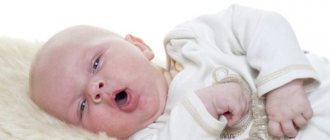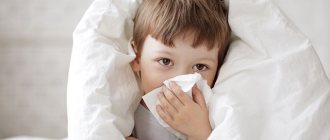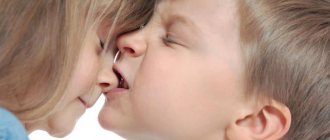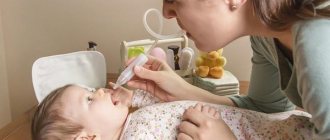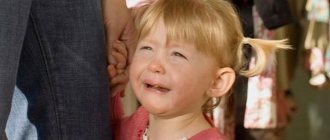One of the common childhood diseases is rhinitis, which is an inflammatory process of the nasal mucosa, or simply a runny nose. Acute rhinitis occurs in both children and adults, but more often in childhood and requires careful treatment.
Typically, a runny nose does not last long or lasts no more than a week, occurs periodically or indicates that the child has a cold. Acute rhinitis in children not only occurs more often than in adults, but is also more severe for a number of reasons:
- early age;
- immature immune system;
- narrow passages in the nose;
- inability to blow your nose well, etc.
This and much more is the reason that acute rhinitis in a child is much more severe. In newborns, the disease affects not only the mucous membrane, but also the entire nasopharynx. In any case, it is important for parents to notice and recognize symptoms as early as possible in order to begin treatment.
Acute rhinitis in a child: causes
Many are accustomed to treating such a “common” disease on their own, but experts strongly do not recommend dealing with rhinitis with your own hands. The nature of the disease in a child and an adult is different, so treatment of acute rhinitis in children should be based on the cause of its occurrence and carried out by a good specialist. What causes rhinitis:
- colds caused by respiratory viruses or bacteria;
- untreated cold;
- weakened immune system;
- allergy;
- deviated nasal septum;
- hypothermia;
- infectious diseases (measles, rubella, diphtheria, etc.);
- intestinal viruses;
- tuberculosis, scleroma, gonorrhea (in rare cases), etc.
Acute rhinitis in children can be caused by the presence of a foreign body in the nose or injury, as well as inhalation of smoke, fumes, caustic chemicals, etc. If any signs of rhinitis occur, the child should be shown to a doctor and not treated on his own.
The medical department employs experienced, qualified doctors who know how and how to treat acute rhinitis in children, know how to find an approach to each child and try to make every visit of a small patient as comfortable and less stressful as possible. The schedule of visits is drawn up individually in order to achieve the desired result as quickly as possible.
Symptoms
- Sudden onset and bilateral manifestation of symptoms.
- Impaired nasal breathing and nasal discharge (rhinorrhea).
- May be accompanied by a feverish reaction.
To carry out a differential diagnosis, you may additionally need the results of a clinical blood test, cytomorphology of nasal secretions, and the results of microbiological/mycological analysis of nasal discharge. As a rule, such an additional examination is carried out during a prolonged course, when a non-infectious nature - allergic or vasomotor rhinitis - cannot be excluded. A differential diagnosis is also made with rhinosinusitis (infectious or allergic), adenoiditis, and in case of unilateral localization of the process - with a foreign body in the nasal cavity or traumatic rhinitis.
Acute rhinitis in children: symptoms
The main signs of the disease are:
- problems breathing through the nose;
- itching and tickling in the nose;
- sneezing;
- nasal discharge or congestion;
- swelling of the mucous membrane;
- heat;
- headaches.
Occasionally, acute rhinitis in a child is accompanied by a symptom such as convulsions. Due to a stuffy nose, newborns stop breastfeeding normally, resulting in malnutrition, fatigue and poor sleep. And an unhealthy diet, sleep and rest leads to problems with the gastrointestinal tract.
Runny nose in children
In newborns and breastfed children, a runny nose may be the first cause of sleep disturbance and refusal of food and mother's milk.
Allergic rhinitis is very common in school-age children. Constant nasal congestion disrupts breathing and gas exchange in the child’s body. As a result, poor perception of information, apathy, drowsiness, impaired smell function and emotional background in general.
Acute rhinitis in children: stages
The acute form goes as follows:
- Stage 1 – irritation, when swelling of the mucous membrane appears and the nose is stuffy;
- Stage 2 – serous, in which congestion worsens, the baby begins to sneeze, etc.;
- Stage 3 – the appearance of mucopurulent discharge and a further decrease in its volume.
An advanced form of acute rhinitis in a child can develop into pain in the middle ear. Usually, with good treatment and without complications, everything goes away within a week, full recovery occurs on the 8-10th day. It is important for parents to remember that the sooner the correct treatment begins, the easier and faster the recovery will be.
Acute rhinitis in children: treatment
Treatment begins with an initial appointment and a thorough examination. The doctor collects anamnesis, determines symptoms, finds out medical history and asks parents questions in order to determine the cause of acute rhinitis in the child and begin prompt treatment.
Pediatricians and ENT doctors accept medical care in the Moskovsky district of St. Petersburg and are ready to quickly help your child by conducting an examination and prescribing the optimal treatment. If necessary, a consultation with an allergist may be prescribed if acute rhinitis in a child is caused by allergies.
Diagnostics
The doctor may also order examinations:
- nasal swabs for bacteriological, virological and cytological analysis of acute rhinitis in a child;
- blood analysis;
- endoscopy of the nasal cavity;
- X-ray of the paranasal sinuses;
- allergy tests;
- pharyngoscopy.
To diagnose a child with “acute rhinitis” and begin treatment, the doctor only needs to identify the existing symptoms and collect an anamnesis to determine the cause. After this, the doctor draws up a treatment plan, taking into account not only the data obtained, but also the age of the child and any contraindications he has to a particular remedy.
Treatment plan for acute rhinitis in a child
The disease in any form and stage must be treated, because if you ignore the problem (including the complete lack of treatment for acute rhinitis), this often leads to serious complications in the child:
- sinusitis;
- otitis;
- bronchitis and pneumonia (in especially severe cases), etc.
Do not risk the health of your child, contact the specialists of the Energo clinic, who know how and how to treat acute rhinitis in children with a wide variety of symptoms and at all stages of the disease. To eliminate the symptoms and causes of the disease, the following are prescribed:
- drug treatment with vasoconstrictor, anti-inflammatory, antibacterial, antiviral medications (selected according to age and stage of the disease);
- physiotherapeutic treatment.
One of the important points in the successful treatment of acute rhinitis in children is the relief of symptoms, as well as the rapid prevention of consequences.
It is important to diagnose the disease as quickly as possible and consult a doctor. The following are also used as treatment methods for acute rhinitis in children:
- sucking out mucus and getting rid of crusts by softening them (the method is used mainly for infants);
- rinsing the nasal cavity with a special solution;
- inhalation;
- treatment of the nasal cavity with antiseptics.
As physiotherapy in the treatment of acute rhinitis in children, the following procedures can be prescribed (according to the symptoms of a particular child):
- OKUF therapy;
- UHF;
- endonasal electrophoresis;
- paraffin treatment.
Typically, treatment of acute rhinitis in children does not require hospitalization and is carried out on an outpatient basis until all symptoms disappear completely.
At the same time, it is necessary to create conditions at home favorable for the child’s recovery: try to maintain a comfortable temperature and high humidity in the room where the baby is. Drinking plenty of warm fluids is also helpful. And we remind you once again: the treatment of acute rhinitis in children should not be carried out by parents on their own, especially in terms of the use of medications that can be incorrectly selected and, if used for a long time, cause harm to the baby’s body.
The doctors of our center, based on extensive practice in the treatment of various childhood diseases, know how to treat acute rhinitis in a child and how to do it correctly and safely for his health. The otolaryngologist will select an individual treatment regimen for rhinitis in your child (including if necessary and severe symptoms), draw up a plan for subsequent visits to monitor the progress of treatment and ensure the effectiveness of the selected medications and methods.
E.Yu. Radzig
Department of ENT Diseases, Russian State Medical University, Moscow
Rhinitis is the most common pathology of the upper respiratory tract, which is treated by pediatricians, family doctors, otolaryngologists and other specialists. The main factor predisposing to the development of rhinitis can be considered hypothermia, which contributes to the disruption of the body's defense mechanisms and the activation of opportunistic microflora in the nasal cavity, nasopharynx and oral cavity. Another factor is a decrease in the body’s resistance due to acute or chronic diseases. The nasal cavity plays the most significant role in the homeostasis of the respiratory tract. By warming, moisturizing and filtering the inhaled air, it performs a protective function. The nasal cavity and bronchi are anatomically interconnected, covered with ciliated epithelium and equipped with an arsenal of congenital and acquired protective mechanisms. Therefore, conditions that cause nasal obstruction may be a trigger for the development of lower respiratory tract pathology. Rhinitis can be the first symptom of an acute respiratory viral infection (ARVI), as well as the beginning of an allergic reaction of the nasal mucosa [1-3]. Currently, the following types of rhinitis are distinguished: • allergic, • infectious, • non-allergic, non-infectious rhinitis (NANIPER - Non-Allergic, Non-Infectious Persistent Rhinitis). According to the World Health Organization document ARIA (Allergis Rhinitis and its Impact on Asthma), seasonal and year-round allergic rhinitis are distinguished, as well as intermittent and persistent course of each of these forms. The same document defines the principles of stepwise therapy of allergic rhinitis, based on the severity of the disease. Currently, the main groups of drugs are: drugs for elimination therapy, antihistamines (systemic and topical), topical steroids. Non-allergic, non-infectious persistent rhinitis (NANIPER) refers to a heterogeneous group of nasal disorders, including occupational rhinitis, medicinal rhinitis, hormonal rhinitis, rhinitis of the elderly and idiopathic vasomotor rhinitis. Infectious rhinitis occurs in approximately half of the adult population. In children, especially young children, this percentage is much higher. It can be nonspecific (the onset of a respiratory infection) and specific, for example, caused by pathogens of infectious diseases - diphtheria, measles, scarlet fever, tuberculosis. It should be remembered that infectious rhinitis (especially recurrent) can lead in the future to the development of asthma and chronic obstructive pulmonary pathology. Highly sensitive techniques detect viral etiology in 80% of schoolchildren with cold symptoms and 50% of adults with asthma. The most common is rhinovirus [5]. In addition, there is also acute traumatic rhinitis [4], caused by trauma to the nasal mucosa (foreign bodies, cauterization, surgical interventions, as well as environmental conditions - dust, smoke, inhalation of chemicals). Classic symptoms of rhinitis are nasal obstruction, rhinorrhea, and sneezing. Acute rhinitis is characterized by a sudden onset and bilateral manifestation of clinical symptoms. The exception is acute traumatic rhinitis, which can be one-sided. The clinical course of acute rhinitis is divided into three stages [4]. The first stage - the dry stage of irritation of the mucous membrane - lasts several hours. The disease begins acutely with a general deterioration in the patient's condition: the body temperature rises to subfebrile levels, headache, hyponasality appear, and the sense of smell decreases, which is caused by the spread of the inflammatory process to the olfactory area. At this stage, the patient notes a burning, tickling and scratching sensation in the nasal cavity. Rhinoscopically, hyperemia of the mucous membrane is determined, there is no discharge, the nasal passages are narrowed, breathing through the nose is difficult. The second stage is the stage of serous discharge. During this period, an abundant amount of serous-mucosal secretion appears due to fluid leaking from the vessels and increased function of goblet cells and mucous glands. This discharge contains table salt, ammonia, biologically active substances and has an irritating effect, especially in children, on the skin of the vestibule of the nose and upper lip, manifested in the form of redness and painful cracks. Rhinoscopically, hyperemia of the mucous membrane is determined, swelling of the nasal turbinates is pronounced (due to vasodilation, stromal edema, overflow of the cavernous plexuses with venous blood), which narrows the lumen of the common nasal passage, and sometimes completely obstructs it, which leads to impaired nasal breathing. Characterized by lacrimation due to irritation of sensitive reflexogenic zones of the nasal mucosa, sneezing. Swelling of the nasal mucosa leads to impaired drainage of the paranasal sinuses and middle ear, which creates favorable conditions for the activation of opportunistic flora and contributes to the development of bacterial complications. The third stage is the stage of mucopurulent discharge. During this period, the nature of the discharge from the nasal cavity changes, it becomes cloudy, then yellowish and greenish. This is due to the presence of leukocytes, epithelial cells and mucin. The patient's condition improves: headache, amount of secretion decreases, unpleasant sensations in the nose (sneezing, lacrimation) disappear, nasal breathing improves. Rhinoscopically, a decrease in hyperemia of the nasal mucosa and swelling of the nasal turbinates (especially the lower ones) is determined; mucopurulent discharge decreases every day and disappears completely. The total duration of acute rhinitis is 8-14 days, it can vary in one direction or another for various reasons. Acute rhinitis can stop after 2-3 days if the child’s general and local immunity is not impaired. In weakened children (often suffering from acute respiratory viral infections) in the presence of chronic foci of infection, acute rhinitis can be protracted - up to 3-4 weeks. Acute rhinitis in infants has its own characteristics. It usually occurs as nasopharyngitis; Often the inflammatory process spreads to the nasopharynx (adenoiditis), middle ear, larynx, trachea, bronchi, and lungs. The child's act of sucking is disrupted, which leads to weight loss, sleep disturbances, and increased excitability. Acute rhinitis is especially severe in premature, weakened children, with a sharply reduced body resistance. It must be taken into account that the causes of acute rhinitis in infants can be gonorrhea and congenital syphilis. Gonorrheal rhinitis usually begins at birth and is associated with eye damage. Congenital syphilitic rhinitis usually manifests itself in the 3-4th week of life, accompanied by the appearance of syphilides on the skin of the buttocks and around the anus, enlargement of the liver and spleen. When treating acute rhinitis, it is not recommended to prescribe menthol or drugs containing it to infants due to the risk of laryngospasm. The diagnosis of acute rhinitis is made on the basis of complaints from the patient or his parents, a carefully collected epidemiological history of the disease, subjective and objective symptoms, and anterior rhinoscopy. Sometimes clinical observations are not enough for differential diagnosis. In these cases, they resort to laboratory research methods: a general blood test, studying the cytological picture using prints from the mucous membrane of the nasal turbinates, and virological tests. Despite great strides in describing the pathophysiological mechanisms of acute viral rhinitis, current advances in treatment are controversial and the wait for effect is long. The wide variability of human virus serotypes makes vaccination impossible. Currently, decongestants (topical and systemic), herbal medicines, physical and reflexive methods of influence are widely used in the treatment of infectious rhinitis [1-3]. For symptoms of rhinitis against the background of normal body temperature, home (not bed) rest, plenty of warm drinks, thermal procedures (hot foot baths and warm compresses on the back of the hands) are prescribed. It is very important to explain to parents or the patient himself that the main thing is to blow your nose correctly, so that, firstly, the nasal cavity is cleaned, and secondly, so that the discharge from the nasal cavity does not fall into the paranasal sinuses and the middle ear cavity. To do this, you need to blow your nose effortlessly and release each half of the nose, alternately pressing the wing of the nose to the septum. The relative area of the nasal mucosa in children is significantly larger than in adults. If an adult dose of a vasoconstrictor per 1 kg of body weight gets on the nasal mucosa of an infant, he will receive a dose 30 times higher than an adult. Due to an overdose, side effects such as increased blood pressure, tremor, and convulsions may occur. Therefore, vasoconstrictor drugs in children, especially young children, should be used with caution, in minimal doses. In the second and third stages of the disease, agents with astringent and disinfectant properties are successfully used. If the symptoms do not decrease within 10 days, mucopurulent discharge from the nose is detected, then a bacterial infection should be assumed and an x-ray examination of the paranasal sinuses should be recommended. However, in the first hours of the disease, it is quite difficult to establish an etiologically significant factor, and the patient’s well-being dictates the need to begin symptomatic therapy. Interesting from this point of view is the complex homeopathic drug Corizalia, produced by the Boiron laboratory (France). The drug is available in the form of film-coated tablets for oral administration. Its components, such as Allium cepa, Sabadilla officinalis, Gelseminum sempervirens, Belladonna atropa, Kalium bichromicum, Pulsatilla vulgaris, make it possible to successfully use it for the treatment of both infectious and various forms of allergic rhinitis. Our clinic assessed the clinical effectiveness of the drug Coryzalia in children with various forms of acute rhinitis (allergic and infectious). The drug was prescribed in an age-specific dosage (according to the instructions attached to the drug) according to an acute regimen (two days), followed by a transition to a maintenance regimen, orally, before meals. Taking other medications and performing physiotherapeutic procedures was not allowed. Children in the control group were prescribed vasoconstrictor drugs and physiotherapeutic procedures (FTU), but without taking the drug Coryzalia. The dynamics of the severity of clinical symptoms (swelling of the nasal mucosa, difficulty breathing, hyposmia, hyperemia of the mucous membrane, sneezing, conjunctival hyperemia, pain in the projection area of the paranasal sinuses, lacrimation) were assessed in points (from 0 to 3 points). Based on the data obtained (the results of a clinical examination), as well as a survey of patients and their parents, it was noted that by the third day of taking the drug Coryzalia, a significant improvement in the condition of children occurs. In the control group, a similar score was noted on the 5th day. For children with various forms of allergic rhinitis, the drug was prolonged to 14-28 days. The dynamics of rhinitis symptoms and rhinoscopic picture are presented in Fig. 1 and 2. Based on the data obtained (the results of a clinical examination), as well as a survey of patients and their parents, the following conclusions can be drawn: • already by the 3-5th day of taking the drug Corizalia, a significant improvement in the condition of children occurs; • prolonged use of the drug does not have a significant effect on the change in score; • the drug is well tolerated by patients. There were no cases of side effects or intolerance to the drug. Summarizing the above, it can be argued that the use of the drug as a monotherapy in treatment protocols for children with various forms of rhinitis can ensure the normalization of nasal breathing and the well-being of patients.
References 1. Samsygina G.A., Bogomilsky M.R. Respiratory tract infections in young children. M.: Miklos. 268 p. 2. Acute respiratory diseases in children: treatment and prevention: a manual for doctors. M., 2002. 70 p. 3. Bogomilsky M.R., Chistyakova V.R. Pediatric otorhinolaryngology. M.: Geotar-med, 2001. 431 p. 4. Kryukov A.I., Arkhangelskaya I.I. Acute rhinitis in children // Consilium medicum. 2001. 5. Hens G., Hellings PW // Rhinology. 2006. 44. 179-187.
Prevention of rhinitis
Any disease is a great stress for children and adults. To avoid frequent visits to the doctor and long-term treatment for both acute rhinitis and other diseases in a child, you must:
- harden the child;
- organize more physical activity for him (physical education, gymnastics, sports clubs, etc.);
- monitor your diet, which should be complete in composition, fortified, etc.
All actions should be aimed at strengthening the immune system. In the process of treating acute rhinitis in a child, the doctor will advise preventive measures and suggest an individual program in accordance with the patient’s age, the developmental characteristics characteristic of children of this age and the individual developmental traits of your baby.
How to make an appointment?
Treatment of acute rhinitis in children should be started in a timely manner to avoid complications in the future and alleviate the child’s condition. Therefore, at the first symptoms, consult a doctor immediately. The sooner treatment begins, the easier and faster it will be, and the less medications the baby will have to take.
In our clinic, diagnosis and treatment of acute rhinitis in children is carried out using modern safe methods and high-precision equipment. To make an appointment and consultation, you can use the online form on the website or call.
Causes of rhinitis
Acute or chronic non-allergic rhinitis in children can occur for various reasons.
The main ones include:
- infection with viral and bacterial infections;
- hypothermia;
- decreased immunity;
- exposure to chemically harmful and dangerous substances;
- dry indoor air;
- poor circulation in the nasal cavity;
- impaired excitability of parts of the autonomic nervous system (typical of the vasomotor form).
